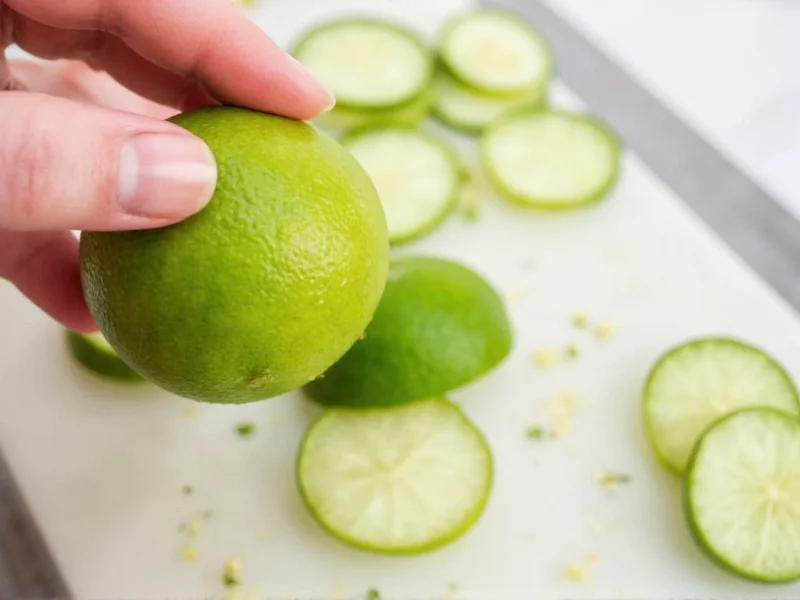Understanding Lime Zest and Its Culinary Value
Lime zest contains essential oils that deliver concentrated citrus flavor far more potent than lime juice. Unlike juice, zest adds vibrant flavor without extra moisture, making it ideal for recipes where liquid content matters. The oils in lime zest contain limonene and other aromatic compounds that provide that distinctive fresh citrus aroma you smell when cutting into a lime.
Essential Tools for Zesting Limes
While several tools work for zesting limes, each produces slightly different results:
| Tool | Best For | Zest Texture | Efficiency |
|---|---|---|---|
| Microplane | Most applications | Fine, fluffy | ★★★★★ |
| Citrus Zester | Striped zest for garnish | Thin strips | ★★★☆☆ |
| Fine Grater | When specialized tools unavailable | Coarse | ★★★☆☆ |
| Vegetable Peeler | Removing larger strips | Wide strips | ★★☆☆☆ |
Step-by-Step Guide to Zesting Limes
Preparation Steps
Before zesting, thoroughly wash limes with warm water to remove any wax or pesticides. Room-temperature limes yield more zest than cold ones, so let refrigerated limes sit out for 15-20 minutes. Pat dry completely—moisture makes zesting difficult.
Zesting with a Microplane
- Hold the microplane over a cutting board or small bowl
- Grip the lime firmly at both ends
- Using downward motions, roll the lime across the blade
- Rotate the lime slightly after each pass
- Stop when you see white pith appearing
- Tap the microplane gently to release zest
Zesting Without Specialized Tools
If you're wondering how to zest limes without a zester, use a vegetable peeler to remove thin strips of peel, then finely mince with a sharp knife. Alternatively, a fine cheese grater works in a pinch—just be extra careful to avoid the bitter pith. For how to get more zest from limes, try freezing the lime for 15 minutes first; the cold makes the peel firmer and easier to zest.
Pro Tips for Perfect Lime Zest
- How much zest in one lime? One medium lime typically yields 1-2 teaspoons of zest
- Always zest before juicing—zesting becomes difficult once the lime is cut
- Apply firm, consistent pressure for even results
- Work quickly to prevent oils from evaporating
- For cocktail rims, zest directly over the glass for maximum freshness
Storing and Using Lime Zest
For immediate use, add zest directly to recipes. To store, place zest in an airtight container in the refrigerator for up to 3 days. For longer storage, freeze zest in ice cube trays with a bit of water or oil, then transfer to freezer bags. Frozen zest keeps for 6 months. When using frozen zest, add it directly to recipes without thawing.
Understanding lime zest vs lime juice is crucial—zest provides intense flavor without acidity or liquid, making it perfect for dishes where texture matters. Use zest to enhance guacamole, fish dishes, baked goods, or cocktails like margaritas. The aromatic oils in zest create a more complex flavor profile than juice alone.
Common Zesting Mistakes to Avoid
Many home cooks make these critical errors when learning how to zest limes properly:
- Zesting too deeply and including bitter white pith
- Using a dull tool that crushes rather than zests
- Zesting refrigerated limes (cold makes zest harder to remove)
- Not washing limes thoroughly before zesting
- Letting zest sit too long before use (oils evaporate quickly)
Creative Ways to Use Lime Zest
Don't limit yourself to basic recipes when you've mastered how to zest limes for cocktails. Try these innovative applications:
- Infuse simple syrup with lime zest for cocktails
- Mix into butter for citrus compound butter
- Add to salt for flavored finishing salt
- Stir into Greek yogurt with honey for breakfast
- Blend with olive oil for vibrant salad dressing











 浙公网安备
33010002000092号
浙公网安备
33010002000092号 浙B2-20120091-4
浙B2-20120091-4